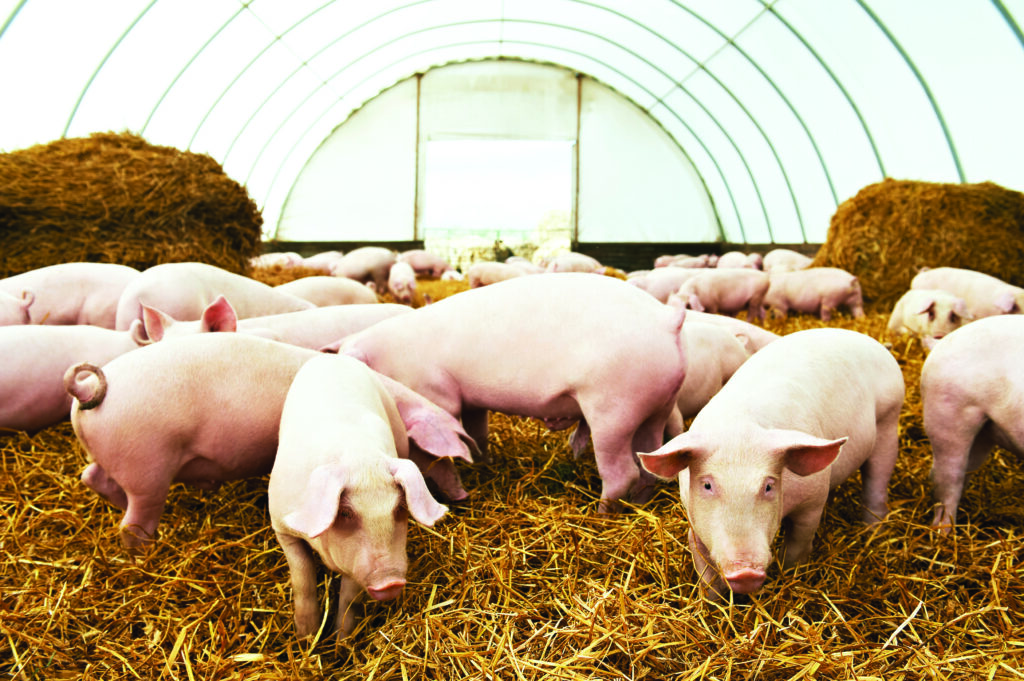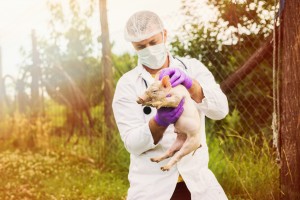Mark White, of the Pig Veterinary Society, will have a big role to play in setting new antibiotic targets for the pig sector. He told Alistair Driver why the pig sector faces a special challenge and how attitude change will hold the key to success
Mark White does not mince his words.
“Serious change is coming,” he said, with pause for effect. “This really is going to be a game-changer on a scale I haven’t seen before and unless, collectively, the industry wakes up to it, some people are going to be in for a real shock.”
Mr White, who, as we met at his home in Worcestershire, was about to be elected as the next president of Pig Veterinary Society (PVS), will play a pivotal role in the setting of new long-term antibiotic targets for the pig sector.
The semi-retired vet, who worked for 30 years as a pig specialist for the Haven Veterinary Group, in Hull, is on the antibiotic Targets Task Force, set up by the Responsible Use of Medicines in Agriculture (RUMA) alliance to oversee the process for each livestock sector.
He is representing the pig sector alongside Richard Lister, chairman of the National Pig Association, which is currently consulting its members on the targets. They will agree a joint position for the pig sector, which will need to be formally submitted on June 5, with a view to reaching agreement on the new targets in July.
While the industry has made excellent progress in reducing and refining antibiotic use over the past 18 months or so, Mr White is concerned that, outside of a well-informed and proactive minority, many have not yet woken up to the magnitude of what is coming.
 He explained why the pig sector is under more pressure than most. The UK livestock industry is currently working towards a target across all sectors, based on sales, of reducing antibiotic use to 50 milligrams of active ingredient per kilogram of livestock (mg/kg) by 2018. It is well on course to achieve it after a 2015 figure of 56mg/kg was recorded, compared with 62mg/kg in 2014.
He explained why the pig sector is under more pressure than most. The UK livestock industry is currently working towards a target across all sectors, based on sales, of reducing antibiotic use to 50 milligrams of active ingredient per kilogram of livestock (mg/kg) by 2018. It is well on course to achieve it after a 2015 figure of 56mg/kg was recorded, compared with 62mg/kg in 2014.
But this cannot mask the fact that the overall average is skewed by relatively low usage by the populous sheep sector. Usage in the pig sector had previously been loosely estimated at around 270mg/kg, based on sales figures of products licensed for pigs and poultry and usage figures claimed by the poultry industry.
Usage targets
With the usage targets likely to run from a baseline of 2015, Mr White predicted that the figure calculated for the pig sector for 2015, based on data uploaded onto the eMB-Pigs database, will end up being slightly lower – ‘either side of 250mg/kg’, with a significant further drop of around 25% expected for 2016.
He said it was vital that pressure from NGOs, and some parts of the supply chain, to take the UK pig sector all the way down to the 50mg/kg mark is resisted, as this would have potentially far-reaching implications for animal health.
“It is something we have got to be alert to because of misinformation in some quarters that the 50mg/kg figure is per sector, when it is an average across all sectors,” he said.
To add to this picture, the Dutch and the Danes have both embarked on ambitious antibiotic reduction programmes with ultimate goals of reaching the 50mg/kg level.
Setting antibiotic targets
* Antibiotic reduction targets to be set for each livestock sector
* A targets task force set up by the Responsible Use of Medicines in Agriculture (RUMA) alliance comprises producer and vet representatives from each sector
* Pig sector represented by Mark White and NPA’s Richard Lister
* Proposed targets to be presented on June 5
* Targets to be agreed with Government by end of July
* Targets likely to run from 2015 to 2020
* Pig industry antibiotic usage baseline (mg/kg) calculated using data uploaded onto eMB-Pigs.
Mr White stressed that these two industries could not be compared with the UK’s for various reasons, including huge government investment in the Danish industry to upgrade facilities and different methodologies used to measure antibiotic usage. The industry structures are very different, too.
The Dutch and, to a lesser extent, the Danes tend to export at weaner age, meaning far fewer finishing pigs, while their industries are far more intensive than ours. The implications of reduced antibiotics on pig health and welfare and the environment in Denmark and the Netherlands also need to be factored in, he added.
“We need to be very conscious of looking at comparison with other countries and fortunately the Veterinary Medicines Directorate is aware of this,” Mr White said. “But this gives some sort of context as to where these figures are going to go.
Substantial reductions
“We are not talking about fluffy-round-the-edges stuff. We are talking about substantial reductions over time. You have then got to ask whether they are achievable without wrecking the industry economically or, more significantly, from a health point of view. That is the delicate balance.”
While the initial target period is likely to run until 2020, the industry needs to be prepared for the fact that once we reach that point, further reduction targets are likely to be put in place. “It will not stop there,” he said.
Mr White acknowledged he carried a huge responsibility into the negotiations. “My career could go rapidly downhill on the back of this if we get the targets wrong and the industry can’t do it,” he half-joked.
So why is UK pig industry antibiotic usage, relatively, so high? Mr White identified three main factors – the systems deployed by UK producers, endemic disease and attitude.
Contrary to the ‘mythology’ put forward by some campaign groups about the link between intensive farming and antimicrobial resistance (AMR), the UK’s high welfare systems – with 40% of sows outdoors and 50-60% of pigs grown on straw – have implications for our herd health, he said.
“The first rule of health control is hygiene. The second rule of health control is hygiene – guess what the third is?” Mr White said. “A big part of our production is in systems that are fundamentally poor hygienically and facilitate faecal oral recycling, which is where most of the gut upset in junior animals comes from.
“Some straw-based systems are on earth floors – how do you clean an earth floor? You have got a fundamental tension between what is perceived to be a higher welfare, straw-based system and hygiene and, therefore, health challenge. It is something that we are going to have to battle with and work through.”
A further issue with pig production, not just in the UK, is that, even with batch systems, animals of varying ages inhabit the site at the same time, he added.
“The younger they are, the more important it is. As maternal immunity drops, challenges come into young pigs and that crossover of pigs becomes a big problem. We have systems that are fundamentally designed in a way that allows recycling of endemic disease.
“That is why, historically, we have relied on what tends to be referred to as routine medication. It is not the pigs that are permanently medicated, it is the farm.”
Disease challenge
Over recent decades, the UK has been challenged by three diseases that have become endemic in the pig herd – porcine reproductive and respiratory syndrome (PRRS), Mycoplasma hyopneumoniae (M. hyo), which causes enzootic pneumonia, and porcine circovirus type 2 (PCV-2).
“These diseases all compromise pigs’ immune systems, so immunity drops away when they are challenged and that opens the door to all sorts of problems from six to 12 weeks of age, which is another reason why we use so much medication,” Mr White said.
But underpinning it all is an attitude to using medication that has become ingrained over many years.
“Over the last 18 months, some of the more forward-looking people have been prepared to change the way they do things, to look at what happens if you take medication out and try new interventions instead. Some companies have put big investment into this,” Mr White said. “But this needs to be replicated across the whole industry.”
He highlighted examples of producers who had threatened to go to another vet after theirs had refused to prescribe antibiotics, and a case where a farmer had threatened to sue if removing antibiotics, as advised by the vet, had a detrimental impact on his income.
“Some people are still not being receptive to change and are still looking for someone else to blame,” he said. “There are going to be some heavy upfront reductions and quite a lot of pain along the way. The industry is going to have to be prepared to move away from this long-term habitual reliance on suppressant medication – the ‘just in case’ attitude. That will require major attitude change.”





